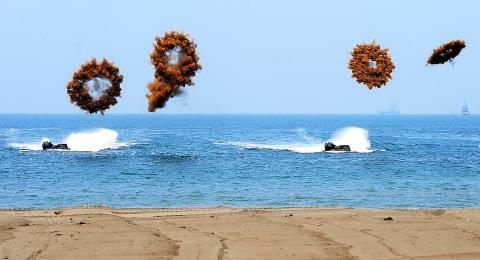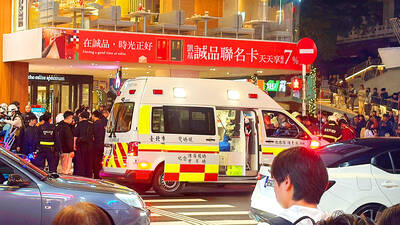A major new Pentagon report on the Chinese military says China is on track to build a modern military by 2020 and that despite improvements in relations across the Taiwan Strait, Taiwan remains the principal focus of the Chinese military.
Fueled by its booming economy, China’s military growth in the past decade has exceeded most US forecasts.
Its aircraft carrier program, cyber warfare capabilities and anti-satellite missiles have alarmed neighbors and Washington, the long-delayed comprehensive 84-page report says.

Photo: Wang Min-wei, Taipei Times
While the report contains nothing that is startlingly new, it is dominated by references to Taiwan. And it comes just weeks before the administration of US President Barack Obama has promised to provide an answer to Taipei’s request to buy 66 advanced F-16C/D aircraft.
This potential arms sale is not mentioned, but without actually spelling it out the study makes it abundantly clear that Taiwan is in desperate need of new weapons.
Titled Military and Security Developments Involving the People’s Republic of China 2011, the annual report to Congress from the US Department of Defense makes chilling reading.
The Obama administration continues to deny that a decision has yet been made on whether or not to sell the F-16s, but unofficial sources in both Taipei and Washington are signaling that Obama will bow to Chinese pressure and not allow the sale. Instead, he seems likely to offer to modernize Taiwan’s dated F-16A/B aircraft — a move that is less objectionable to Beijing.
China’s rise as a major international actor will stand out as a defining feature of the strategic landscape of the early 21st century, the report says.
And China’s modernized military could be used in ways that increase Beijing’s ability to gain diplomatic advantage or resolve disputes in its favor, the report says.
Nowhere is that more the case, the report makes obvious, than in Beijing’s dealings with Taiwan.
“The PLA [People’s Liberation Army] seeks the capability to deter Taiwan independence and influence Taiwan to settle the dispute on Beijing’s terms,” it says.
“In pursuit of this objective, Beijing is developing capabilities intended to deter, delay, or deny possible US support for the island in the event of conflict,” it says.
“The balance of cross-Strait military forces and capabilities continues to shift in the mainland’s [China’s] favor,” it says.
Despite the warming cross-strait ties under President Ma Ying-jeou (馬英九), the report says, China has continued to build its forces in a way that threatens Taiwan.
“In the current decade to 2020, the PLA is likely to steadily expand its military options for Taiwan,” it says.
“Consistent with a near-term focus on preparing for Taiwan Strait contingencies, China continues to base many of its most advanced systems in the military regions opposite Taiwan,” it says.
On top of the huge numbers of ballistic and cruise missiles aimed at Taiwan, the report says China bases 490 combat aircraft within operational range of Taiwan and has the airfield capacity to expand that number by hundreds, as well as about 400,000 of its 1.25 million soldiers based in three military regions opposite Taiwan.
“The possibility of a military conflict with Taiwan, including US military intervention, remains a pressing, long-term focus for the PLA,” the report says.
“In the absence of a peaceful cross-Strait resolution or long-term non-aggression pact, the Taiwan mission will likely continue to dominate PLA modernization and operational planning,” it says.
Although the Chinese military probably lacks the necessary military power to successfully conduct a full-scale amphibious invasion of Taiwan, the report says, it is working to close the gaps in its capabilities.
“Furthermore, Taiwan’s relatively modest defense spending has failed to keep pace with ambitious military developments on the mainland,” it says.
The report says Beijing seeks to deter Taiwanese moves toward independence and seeks to achieve unification with a carrot and stick approach.
“The PRC [People’s Republic of China] strives to integrate the two economies while advancing cultural and historic ties. Politically, China has sought to expand ties with the [Chinese Nationalist Party] KMT Party on Taiwan while attempting to isolate political entities with more overtly pro-independence leanings,” it says.
“The PRC employs economic enticement, propaganda, and political engagement in pursuit of these objectives,” it says.
According to the report, the military component of China’s strategy is intended to create an impression on Taiwan that accommodation with Beijing is ultimately in Taiwan’s best interest.
“Beijing appears prepared to defer the use of force as long as it believes long-term reunification [sic] remains possible and the costs of conflict outweigh the benefits,” it says.
US Deputy Assistant Secretary of Defense for East Asia Michael Schiffer told a Pentagon press briefing on the report that the pace and scope of China’s sustained military investments had allowed Beijing to pursue capabilities that “we believe are potentially destabilizing to regional military balances, increase the risk of misunderstanding and miscalculation, and may contribute to regional tensions and anxieties.”
He said the report pointed to cross-strait trends that created a very challenging military and security environment.
The US was committed to working with Taiwan, to meet its -commitments under the Taiwan Relations Act (TRA) and to ensure that Taipei had the self-defense capabilities that it needed, Schiffer said.
Asked directly about the possible sale of F-16C/Ds, Schiffer said: “There have been no decisions that have been made on arms sales to Taiwan.”
“This is an issue that we continue to work with on a daily basis and consistent with our obligations under the Taiwan Relations Act, the United States will provide to Taiwan the self-defense capabilities that it requires,” he said.
“It’s a challenging security environment across a number of different dimensions,” he said when pressed on the possible sale.
There was no “silver bullet that will all of a sudden change everything,” he said.
In Taipei, the Ministry of National Defense again urged the US government to speed up the sale of defensive weapons to Taiwan.
Ministry spokesman David Lo (羅紹和) said the report again highlighted the cross-strait military imbalance.
Based on this reasoning, Ma has repeatedly called on the US to supply defensive arms to Taiwan in accordance with the TRA, Lo said.
He said the ministry has continued in its efforts to persuade Washington to provide F-16C/D aircraft, F-16A/B upgrades and diesel-electric submarines.
The Chinese government has yet to give its official response to the report, but Xinhua news agency fired the first shot in an English-language commentary yesterday, condemning the report as an alarmist “cock-and-bull story” that was “based on a wild guess and illogical reasoning.”
“China, which has adhered to a defensive military policy, with its rising economic clout and sprawling commercial and strategic interests around the world, has every right to build a competent military,” it said.
Xinhua called the Pentagon’s conclusions “much ado about nothing,” and said Chinese people thought it “baffling” that the US could criticize China when its own military spending was 40 percent of the world’s total last year.
Additional reporting by Reuters and CNA

TRAGEDY STRIKES TAIPEI: The suspect died after falling off a building after he threw smoke grenades into Taipei Main Station and went on a killing spree in Zhongshan A 27-year-old suspect allegedly threw smoke grenades in Taipei Main Station and then proceeded to Zhongshan MRT Station in a random killing spree that resulted in the death of the suspect and two other civilians, and seven injured, including one in critical condition, as of press time last night. The suspect, identified as a man surnamed Chang Wen (張文), allegedly began the attack at Taipei Main Station, the Taipei Fire Department said, adding that it received a report at 5:24pm that smoke grenades had been thrown in the station. One man in his 50s was rushed to hospital after a cardiac arrest

SAFETY FIRST: Double the number of police were deployed at the Taipei Marathon, while other cities released plans to bolster public event safety Authorities across Taiwan have stepped up security measures ahead of Christmas and New Year events, following a knife and smoke bomb attack in Taipei on Friday that left four people dead and 11 injured. In a bid to prevent potential copycat incidents, police deployments have been expanded for large gatherings, transport hubs, and other crowded public spaces, according to official statements from police and city authorities. Taipei Mayor Chiang Wan-an (蔣萬安) said the city has “comprehensively raised security readiness” in crowded areas, increased police deployments with armed officers, and intensified patrols during weekends and nighttime hours. For large-scale events, security checkpoints and explosives

A car bomb killed a senior Russian general in southern Moscow yesterday morning, the latest high-profile army figure to be blown up in a blast that came just hours after Russian and Ukrainian delegates held separate talks in Miami on a plan to end the war. Kyiv has not commented on the incident, but Russian investigators said they were probing whether the blast was “linked” to “Ukrainian special forces.” The attack was similar to other assassinations of generals and pro-war figures that have either been claimed, or are widely believed to have been orchestrated, by Ukraine. Russian Lieutenant General Fanil Sarvarov, 56, head

PUBLIC SAFETY: The premier said that security would be tightened in transport hubs, while President Lai commended the public for their bravery The government is to deploy more police, including rapid response units, in crowded public areas to ensure a swift response to any threats, President William Lai (賴清德) said yesterday after a knife attack killed three people and injured 11 in Taipei the previous day. Lai made the remarks following a briefing by the National Police Agency on the progress of the investigation, saying that the attack underscored the importance of cooperation in public security between the central and local governments. The attack unfolded in the early evening on Friday around Taipei Main Station’s M7 exit and later near the Taipei MRT’s Zhongshan